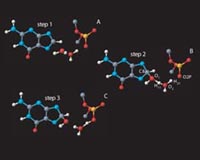| . |  |
. |
Paris (AFP) Feb 3, 2010 Fog-catching nets which provide precious water in rain-starved parts of the world may be poised for a high-tech upgrade thanks to the spider. In a paper published in the journal Nature on Wednesday, Chinese scientists report on why spider's silk is not only famous for strength but also terrific for collecting water from the air, sparing the creature a hunt for a drink. The secret, revealed by scanning electron microscope, lies in the silk's tail-shaped protein fibres which change structure in response to water. Once in contact with humidity, tiny sections of the thread scrunge up into knots, whose randomly arranged nano-fibres provide a roughly, knobbly texture. In between these "spindle knots" are joints, which are smooth and slender, comprising neatly aligned fibres. Small droplets then condense randomly on the spider's web. Once they reach a critical size, the droplets slide along the slick-surfaced joints thanks to surface tension. The droplets then reach the spindle knots, where they coalesce with larger drops. As a result, the joints are freed up to begin a new cycle of condensation and water collection. The researchers, led by Lei Jiang of the Chinese Academy of Sciences in Beijing, looked at the silk made by the cribellate spider (Uloborus walckenaerius), which uses a little comb, or cribellum, to separate fibres and spin them into various kinds. After making their observations, they fabricated fibres aimed at replicating the silk's microscopic structure. "Our artificial spider silk not only mimics the structure of wet-rebuilt spider silk but also its directional water collection capability," they claim. The breakthrough will help the development of man-made fibres that will help water collection and could also be used in manufacturing processes to snare airborne droplets, they believe. Fog collection entails stretching out nets or canvas on poles and using the mesh to catch moisture from the breeze. The runoff is collected in a pipe or a trough on the ground. The technique, pioneered in the coastal Andes, is being encouraged in poor, dry parts of the world, such as Nepal. It is also being promoted by charities as a useful tool to offset water stress caused by global warming.
Share This Article With Planet Earth
Related Links Darwin Today At TerraDaily.com
 Organisms Can Tolerate Mutations Yet Adapt To Change
Organisms Can Tolerate Mutations Yet Adapt To ChangePhiladelphia PA (SPX) Feb 03, 2010 Biologists at the University of Pennsylvania studying the processes of evolution appear to have resolved a longstanding conundrum: How can organisms be robust against the effects of mutations yet simultaneously adaptable when the environment changes? The short answer, according to University of Pennsylvania biologist Joshua B. Plotkin, is that these two requirements are often not contradic ... read more |
|
| The content herein, unless otherwise known to be public domain, are Copyright 1995-2010 - SpaceDaily. AFP and UPI Wire Stories are copyright Agence France-Presse and United Press International. ESA Portal Reports are copyright European Space Agency. All NASA sourced material is public domain. Additional copyrights may apply in whole or part to other bona fide parties. Advertising does not imply endorsement,agreement or approval of any opinions, statements or information provided by SpaceDaily on any Web page published or hosted by SpaceDaily. Privacy Statement |